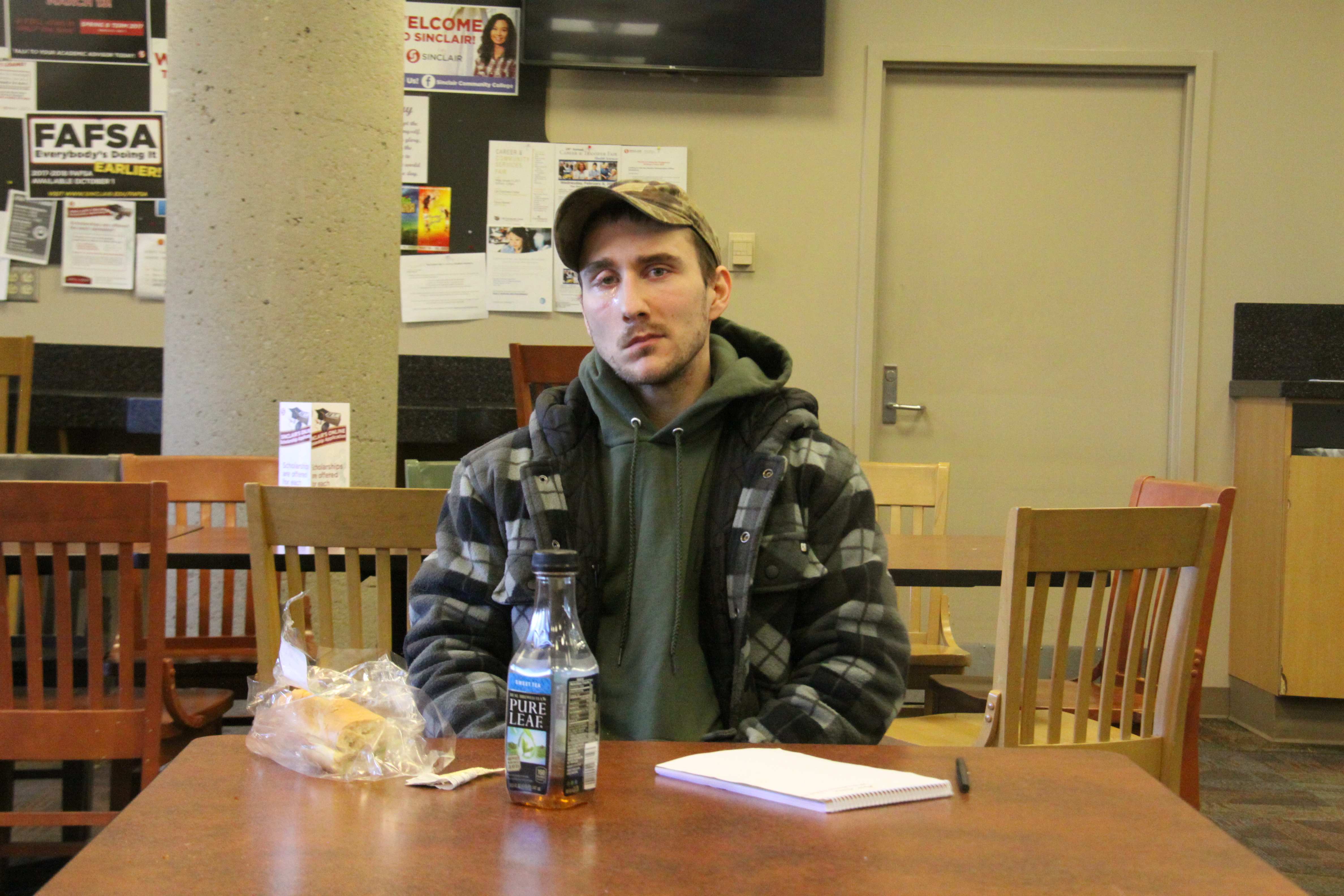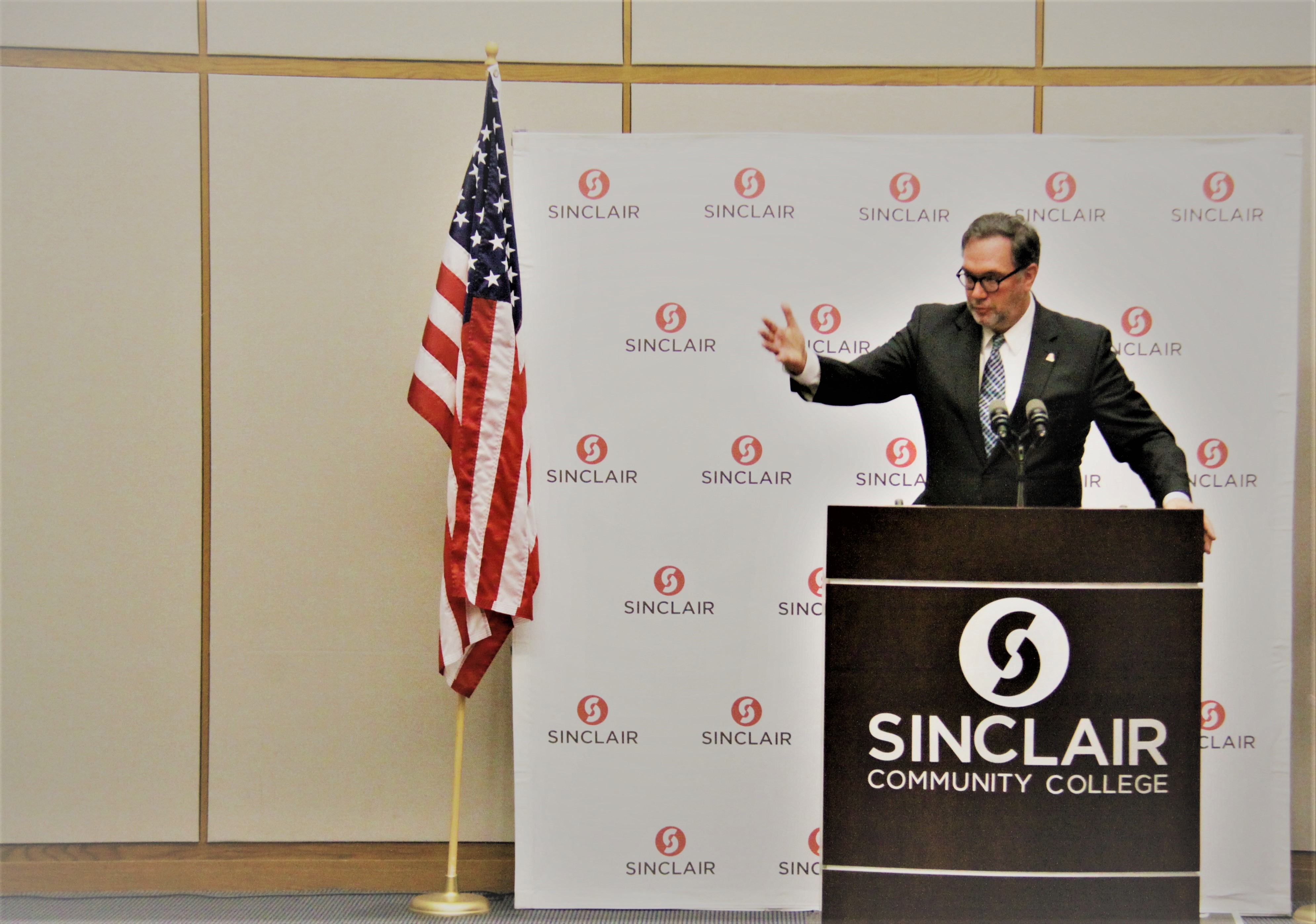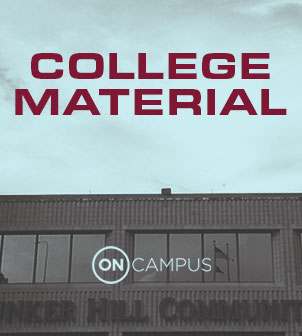
Iraq war veteran Matt Pelkey, 29, is studying mechanical engineering at Sinclair Community College in Dayton, where taxpayers overwhelmingly support a tax that subsidizes tuition and fees. (Kirk Carapezza/WGBH)
Americans are increasingly anxious about widening economic gaps – gaps between the poor and the wealthy, the educated and the uneducated. In the post-industrial Midwestern city of Dayton, Ohio, taxpayers have been banking on their community college to reduce inequality, revitalize the local economy and restore the American Dream.
When Matt Pelkey graduated from high school, instead of going straight to college, he joined the Marines.
“I wasn’t ready to go to college right out of high school,” Pelkey said. “I didn’t have the mindset."
After serving two tours of duty in Iraq as a mechanic, the 29-year-old suffered a brain tumor and underwent surgery. He found himself back home in Dayton, Ohio, earning $12.50 an hour making brake hubs for 18-wheelers just four months after having major brain surgery.
“They weighed eighty pounds apiece,” he recalled. “I [was] getting light-headed and dizzy, and I [felt] like I’m going to fall into my machine.”
So, for the first time in ten years Pelkey went back to school. He enrolled at Sinclair Community College in Dayton, hoping to earn a two-year associate’s degree in mechanical engineering.
Cost wasn’t an issue.
At about $1,000 a year – or $100 per credit hour – Sinclair is one of the most affordable community colleges in the country. That’s because, for the past 50 years, as Dayton hemorrhaged well-paying blue-collar jobs to automation and the global economy, voters have given widespread bipartisan support to a property tax designed to subsidize tuition for the 30,000 students at Sinclair.
In November, after a polarizing election season, Dayton turned out for Hillary Clinton and Montgomery County for Donald Trump. But the county’s community college tax passed easily.
“Higher education keeps people in place,” said Dayton Mayor Nan Whaley.
Sitting at a small table in the back of the Trolley Stop bar in the city’s historic district, Whaley admits that one of the problems Dayton faces is that massive job and population loss has been a shock to a city built for a million people. Today, Dayton only has 140,000 residents.
But there’s another numbers problem with which Dayton is dealing. Only one in five of its high school graduates earn a college degree within six years. Recognizing that gap, Whaley, a Democrat, and the Montgomery County sheriff, a Republican, have overcome their political differences to lead the community college property tax campaign.
“Dayton is the kind of city where the networks are broader than the politics,” Whaley explained.
The community college property tax remains popular, she says, because it doesn’t just support students, but also the local economy at a time when nearly all well-paying jobs have gone to workers with at least some education or training beyond high school.

For decades, Montgomery County voters have given bipartisan support to a property tax designed to lower tuition and fees at Sinclair Community College. (Kirk Carapezza/WGBH)
“Sinclair does a good job of listening to what the workforce needs are in the community and adjusting every single year, taking credentials off, putting credentials on,” Whaley said. “And because they have that support from the local community, they pay, I think, a great deal of attention to it."
As the Dayton region works through a lot of cyclical changes, Sinclair President Steve Johnson says the steady public support has allowed his community college to improve degree programs. Sinclair carefully coordinates its curriculum with small advanced manufacturing companies, Wright Patterson Air Force Base and a chain of local hospitals owned by Premier Health.
Related: Community Colleges: Affordable, Practical, and Increasingly Popular
Johnson says Sinclair's graduates are seeing the benefits in their paychecks. On average, Sinclair students earn about $17,000 the year before they graduate. Upon graduation, their median pay more than doubles to $37,000.
"The jump in salary that our students see is tremendous,” Johnson said. “When you look at specific fields, like in healthcare, it’s even higher than that.”

Sinclair Community College president Steve Johnson says the local tax holds his institution accountable. (Kirk Carapezza/WGBH)
"Attracting talent to Dayton is critical,” said Barbara Johnson, Premier Health’s chief human resources officer. “Keeping talent in Dayton is critical.”
The hospital chain employs more than 14,000 people in southwestern Ohio and a large percentage of them are Sinclair grads.
"So many of the degrees that support healthcare are two-year degrees,” Johnson said. “All come through certification programs that we've partnered with and aligned with Sinclair to create."
Johnson says Sinclair has exceeded Premier’s expectations in providing training to make sure it has the talent it needs to stay competitive.
That optimism, the idea that economic revival will come through specialized education, is widespread in Dayton.
Economists, though, say it won't be so easy to turn things around in the Rust Belt.
"It's difficult to make those transformations, but that's the right direction to go," said David Autor, a labor economist at the Massachusetts Institute of Technology.
His research finds in cities like Dayton the earnings gap between college graduates and everyone else has soared in recent decades. In some ways, Autor notes, the American higher education system is exacerbating income inequality rather than ameliorating it.
"The median earnings differential between a household with two college-educated working adults and two high-school educated working adults has risen by almost $30,000 between 1979 and 2012,” Autor said. “That's an enormous amount of money."
Earlier: National Survey Shows High Rates Of Hungry And Homeless Community College Students
Autor says the community college property tax seems to be working in Dayton, but he questions whether the same model could work in other de-industrialized communities. Targeted investment in well-designed community college programs could generate higher earnings and better livelihoods. But what’s not clear is whether the community itself will reap the rewards.
While southwestern Ohio is losing young workers at a faster clip than most regions in the country, economists point out Dayton is doing better. That's at least in part because 96 percent of Sinclair graduates stick around.
When veteran Matt Pelkey graduates next spring, he plans to stay in the Dayton area.
"I'm not necessarily looking for the huge wage increase so much as just trying to stay in the field that I love working in," he said.
Pelkey hopes to find a job in advanced manufacturing – not lifting those heavy brake hubs, but designing parts for driverless cars.
This is part one in our series examining college completion efforts and higher education innovation in and around Dayton, Ohio.
Part Two: Ohio Bets Big On ‘Early College’ For Underprivileged Students










